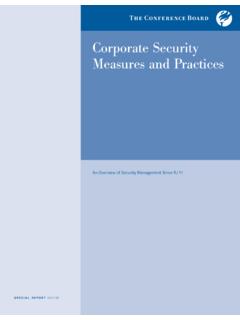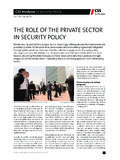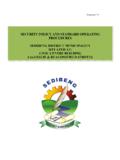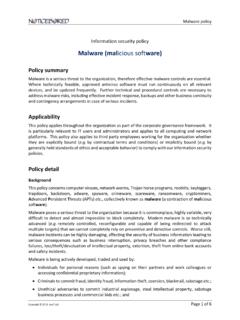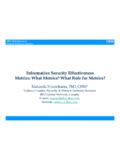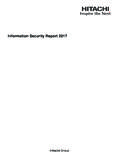Transcription of Server Security Policy - CPCS Tech
1 Server Security Policy Purpose The purpose of this Policy is to establish standards for the base configuration of internal Server equipment that is owned and/or operated by <Company Name>. Effective implementation of this Policy will minimize unauthorized access to <Company Name> proprietary information and technology. Scope This Policy applies to Server equipment owned and/or operated by <Company Name>, and to servers registered under any <Company Name>-owned internal network domain. This Policy is specifically for equipment on the internal <Company Name> network. For secure configuration of equipment external to <Company Name> on the DMZ, refer to the Internet DMZ Equipment Policy . Policy Ownership and Responsibilities All internal servers deployed at <Company Name> must be owned by an operational group that is responsible for system administration.
2 Approved Server configuration guides must be established and maintained by each operational group, based on business needs and approved by InfoSec. Operational groups should monitor configuration compliance and implement an exception Policy tailored to their environment. Each operational group must establish a process for changing the configuration guides, which includes review and approval by InfoSec. Servers must be registered within the corporate enterprise management system. At a minimum, the following information is required to positively identify the point of contact: o Server contact(s) and location, and a backup contact o Hardware and Operating System/Version o Main functions and applications, if applicable Information in the corporate enterprise management system must be kept up-to-date.
3 Configuration changes for production servers must follow the appropriate change management procedures. General Configuration Guidelines Operating System configuration should be in accordance with approved InfoSec guidelines. Services and applications that will not be used must be disabled where practical. Access to services should be logged and/or protected through access-control methods such as TCP Wrappers, if possible. The most recent Security patches must be installed on the system as soon as practical, the only exception being when immediate application would interfere with business requirements. Trust relationships between systems are a Security risk, and their use should be avoided. Do not use a trust relationship when some other method of communication will do.
4 Always use standard Security principles of least required access to perform a function. Do not use root when a non-privileged account will do. If a methodology for secure channel connection is available ( , technically feasible), privileged access must be performed over secure channels, ( , encrypted network connections using SSH or IPSec). Servers should be physically located in an access-controlled environment. Servers are specifically prohibited from operating from uncontrolled cubicle areas. Monitoring All Security -related events on critical or sensitive systems must be logged and audit trails saved as follows: o All Security related logs will be kept online for a minimum of 1 week. o Daily incremental tape backups will be retained for at least 1 month.
5 O Weekly full tape backups of logs will be retained for at least 1 month. o Monthly full backups will be retained for a minimum of 2 years. Security -related events will be reported to InfoSec, who will review logs and report incidents to IT management. Corrective measures will be prescribed as needed. Security -related events include, but are not limited to: o Port-scan attacks o Evidence of unauthorized access to privileged accounts o Anomalous occurrences that are not related to specific applications on the host. Compliance Audits will be performed on a regular basis by authorized organizations within <Company Name>. Audits will be managed by the internal audit group or InfoSec, in accordance with the Audit Policy .
6 InfoSec will filter findings not related to a specific operational group and then present the findings to the appropriate support staff for remediation or justification. Every effort will be made to prevent audits from causing operational failures or disruptions. Enforcement Any employee found to have violated this Policy may be subject to disciplinary action, up to and including termination of employment. Definitions Term Definition DMZ De-militariezed Zone. A network segment external to the corporate production network. Server For purposes of this Policy , a Server is defined as an internal <Company Name> Server . Desktop machines and Lab equipment are not relevant to the scope of this Policy . Revision History
